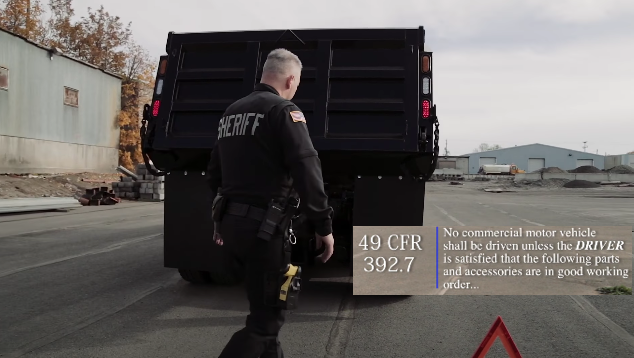The Commercial Vehicle Safety Alliance (CVSA) has announced the International Roadcheck dates and structure for 2022. The event is designed to help ensure that commercial vehicles are safe and compliant with the new safety regulations. The goal is to reduce fatalities and injuries in the commercial transportation industry.
Quick Facts
- International Roadcheck began in 1988
- 1.4 Million inspections have been conducted since it’s inception
- On average, 15 vehicles are inspected every minute
- The ‘blitz’ lasts 72 hours in total
Details on International Roadcheck 2022
As per the CVSA website, “International Roadcheck is a 72-hour high-visibility, high-volume commercial motor vehicle inspection and enforcement initiative. Commercial motor vehicle inspectors in Canada, Mexico and the U.S. will conduct North American Standard Inspections of commercial motor vehicles and drivers at weigh and inspection stations, on roving patrols, and at temporary inspection sites.”
However, some states take matters into their own hands by conducting independent inspection events. For example, Texas conducted their own CMV Blitz on February 07, 2022 which resulted in 90 inspections, 1 arrest, 64 vehicles placed OOS, and 455 equipment violations. As well as many other infractions with varying degrees of severity.
The focus for 2022 will be on Wheel-Ends. Violations involving wheel end components historically account for about one quarter of the vehicle out-of-service violations discovered during International Roadcheck. Expect officers not to stop at inspecting just the wheel studs and lugs though. Assume that they will pay extra attention to things like:
- Brake drums
- Brake shoes
- Slack Adjusters
- Brake Chambers (especially pushrod stroke)
- Wheel bearing covers
- Leaf springs & brackets
- Brake lines
- Airbags
- Axle seals
- Steering wheel play
- Valve stem covers
- Tire tread depth
- Steering linkages
It should also be assumed that the DOT will be validating documentation from all drivers chosen for inspection as well. Put simply, make sure you and/or all your drivers are in compliance with in-cab paperwork regulations.
Companies should be sure to talk with drivers before the blitz week to ensure they know how to conduct a proper pre/post-trip inspection. Although the DOT chooses a focus area, it’s highly unlikely that they will forgo a quick climb-under inspection of the rest of the unit.
Quick tip: Driver behavior has an effect on the outcome of a roadside inspection. Drivers who are able to communicate effectively will have the highest chance of a positive experience during the inspection.
In addition to the International Annual Roadcheck, there are also inspection events at the county level in some places. For example, in Dunn County, Wisconsin, an enforcement effort will take place on I-94 and I-43 using 3 aircraft (Cessna 172 Skyhawks) to monitor driving behavior for speeding/aggressive driving.
Level 1 North American Standard Inspections
Will be the primary inspection type to take place during that week. Companies should familiarize their drivers, and especially their technicians on the scope of this level of inspection. It basically covers everything that mechanics are tasked with inspecting during a preventive maintenance procedure but without the luxury of doing it in a shop.
More specifically, a Level 1 Inspection includes examination of:
- Driver’s license
- Medical Examiner’s Certificate
- Skill Performance Evaluation (SPE) Certificate (if applicable)
- Alcohol and drugs
- Driver’s record of duty status
- Seat belt
- Vehicle inspection report(s)
- Brake systems
- Cargo securement
- Coupling devices
- Driveline/driveshaft
- Exhaust systems
- Frames
- Fuel systems
- Lighting devices (headlamps, tail lamps, stop lamps, turn signals and lamps/flags on projecting loads)
- Steering mechanisms
- Suspensions
- Tires
- Van and open-top trailer bodies
- Wheels, rims and hubs
- Windshield wipers
For buses, motor-coaches, passenger vans or other passenger-carrying vehicles:
- Emergency Exits
- Electrical cables and systems in engine and battery compartments
- Seating
- HM/DG and specification cargo tank requirements, as applicable.
- HM/DG required inspection items will only be inspected by certified HM/DG and cargo tank inspectors, as applicable.
Out-of-Service Inspection Criteria
Officers will be following the North American Standard Out-of-Service Criteria, which requires the inspector to restrict the driver or vehicle from travel until violations are fixed. This could spell trouble for trucks far away from the terminal. This is even more the reason to invest a little time into preparing drivers & mechanics beforehand.
In summary, the International Roadcheck is nothing to stress about as long as you’ve taken the proper steps beforehand to make sure drivers and mechanics are prepared. It should be noted, however, that the overall % of vehicles placed OOS will have an effect on the availability of roadside repair services.
Another tip for getting through the week unscathed is to have drivers pay extra attention to the things that normally go unnoticed. Things like Truck/trailer cleanliness, traveling speed, following distance, etc. These all play a big part in the likelihood of getting pulled off to the side of the road or into an inspection station.


